Key takeaways:
- Experimenting with different types of flour and ingredients can significantly alter the texture and flavor of homemade pasta.
- Customization in cooking involves balancing flavors, adjusting cooking times, and incorporating unexpected ingredients to enhance dishes.
- Sharing personalized pasta recipes not only showcases culinary skills but also fosters connections and creates lasting memories with others.
- Tasting and trusting your senses are essential for perfecting pasta dishes, with high-quality ingredients playing a crucial role in elevating flavors.
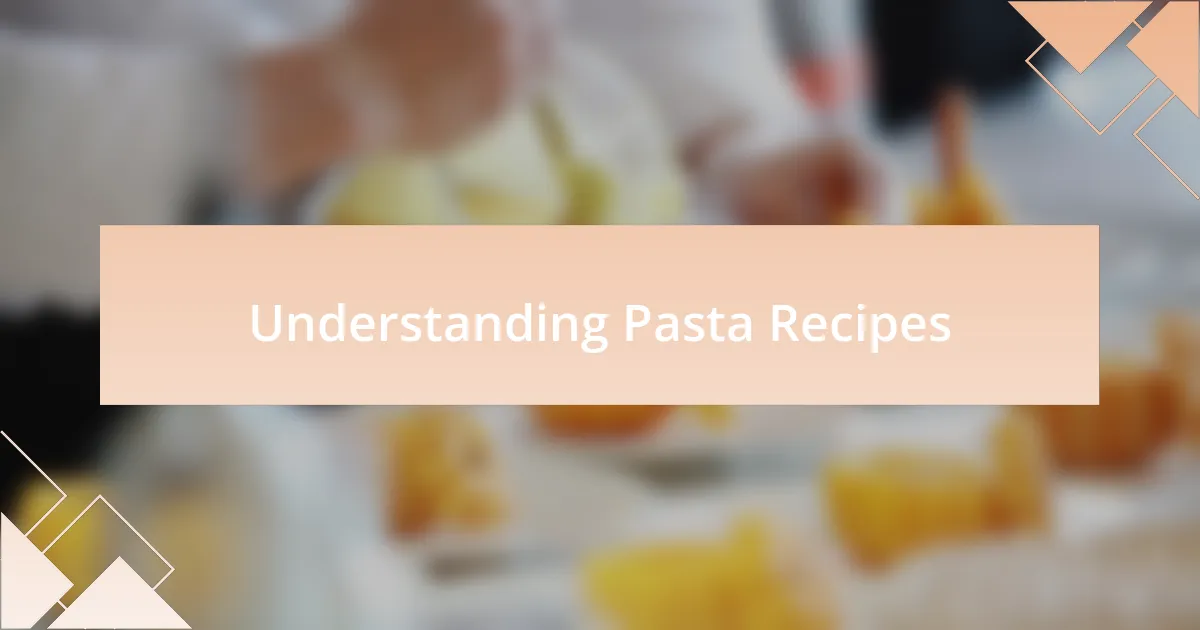
Understanding Pasta Recipes
Pasta recipes can be surprisingly versatile. I remember my first attempt at homemade pasta, feeling a mix of excitement and fear. It made me realize how just a few ingredients like flour, eggs, and water can transform into countless shapes and flavors with the right technique.
Understanding the basic components is essential for any aspiring pasta chef. For instance, did you know that the type of flour you choose significantly impacts the final texture of your pasta? The first time I swapped all-purpose flour for semolina, I couldn’t help but feel a rush of joy at the firmer, chewier result—like I had unlocked a new level in my cooking journey.
The beauty of pasta lies in its adaptability. As I experimented with different sauces and add-ins—like sautéed garlic and seasonal veggies—I discovered the joy of personalizing each dish to reflect my mood or the ingredients I had available. Have you ever found yourself in a similar situation, where a simple recipe evolved into something uniquely yours? Those moments of creativity are truly what make cooking an art form, and they encourage me to continue pushing the boundaries of tradition.
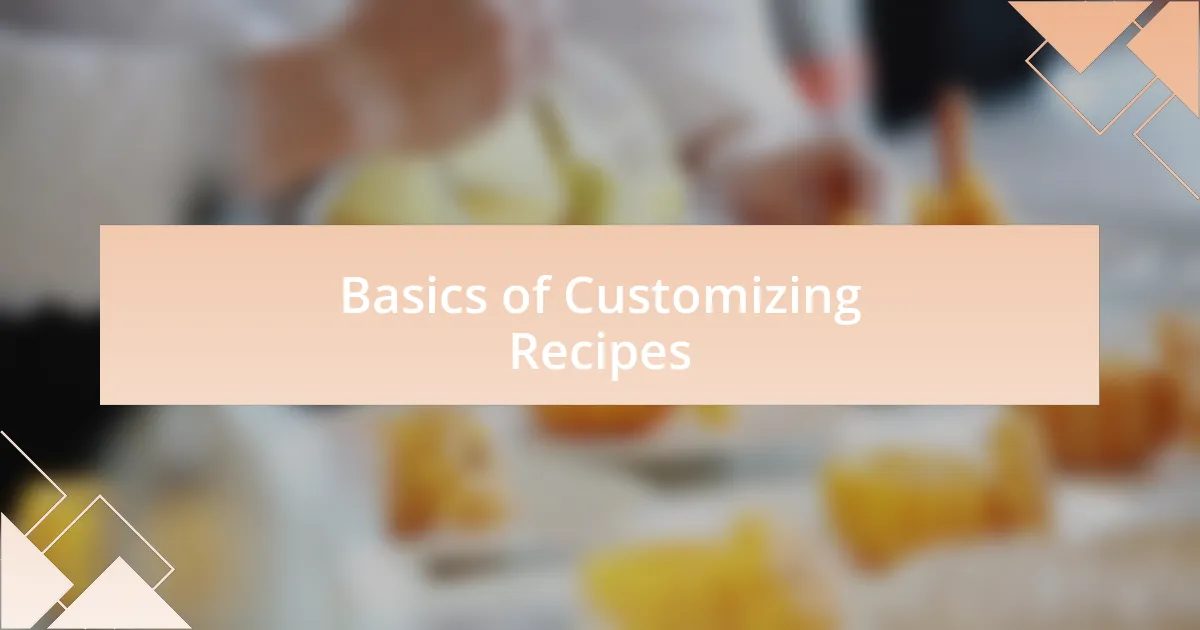
Basics of Customizing Recipes
When it comes to customizing recipes, it all starts with understanding the core elements. For example, during my pasta journey, I learned early on that swapping ingredients isn’t just about preference; it’s about transforming the dish entirely. The first time I added a pinch of nutmeg to a béchamel sauce, I was astounded by how it elevated the flavor profile—suddenly, it wasn’t just sauce; it was an experience on the plate.
One of my favorite methods for personalizing a recipe is adjusting the balance between flavors. The right herbs can completely change a dish’s character. I vividly remember the first time I introduced fresh basil instead of dried oregano into my sauce; it brought a vibrant freshness that made the meal feel like summer. Have you ever thought about how a simple switch can evoke different memories or feelings through flavor?
Texture also plays a vital role in customization. While preparing pasta, I often experiment with different cooking times to achieve that perfect bite. I recall an evening when I accidentally cooked my noodles a minute too long, turning them into a mushy mess. It was disappointing but taught me the importance of attention to detail. So, how do you approach the balance of cooking time and texture in your own culinary adventures? Finding that sweet spot can truly transform your dishes into something extraordinary.
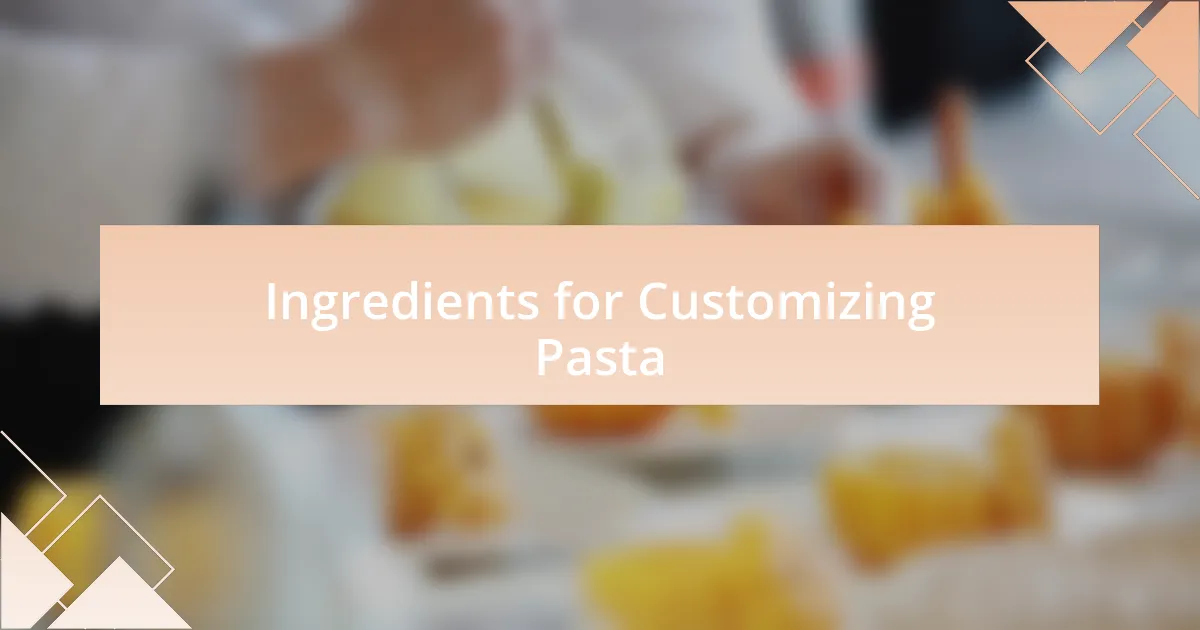
Ingredients for Customizing Pasta
When customizing pasta, the choice of base ingredients is crucial. For instance, I often experiment with different types of flour, like semolina or whole wheat, to see how they change both the texture and flavor of the pasta. Each blend offers a unique twist, evoking different culinary traditions – have you tried making pasta with chickpea flour? It adds a delightful nuttiness that’s hard to resist.
I’ve found that adding unexpected ingredients can open up a whole new world of flavors. One rainy afternoon, I decided to incorporate roasted garlic into my dough, and the aroma that filled my kitchen was nothing short of magical. It transformed the pasta into a fragrant delight that paired beautifully with a simple olive oil dressing. Do you remember a time when an ingredient took your dish to a whole new level? Those moments are what keep us in the kitchen, experimenting and learning.
Don’t overlook the importance of finishing touches, whether it’s a sprinkle of cheese or a splash of olive oil. I distinctly recall a dinner where I topped my homemade spaghetti with freshly grated Parmigiano-Reggiano and cracked black pepper. The rich, salty notes combined with the pepper’s warmth completed the dish, showcasing how even a small addition can elevate your culinary creation. What ingredients have you discovered that make your pasta stand out?
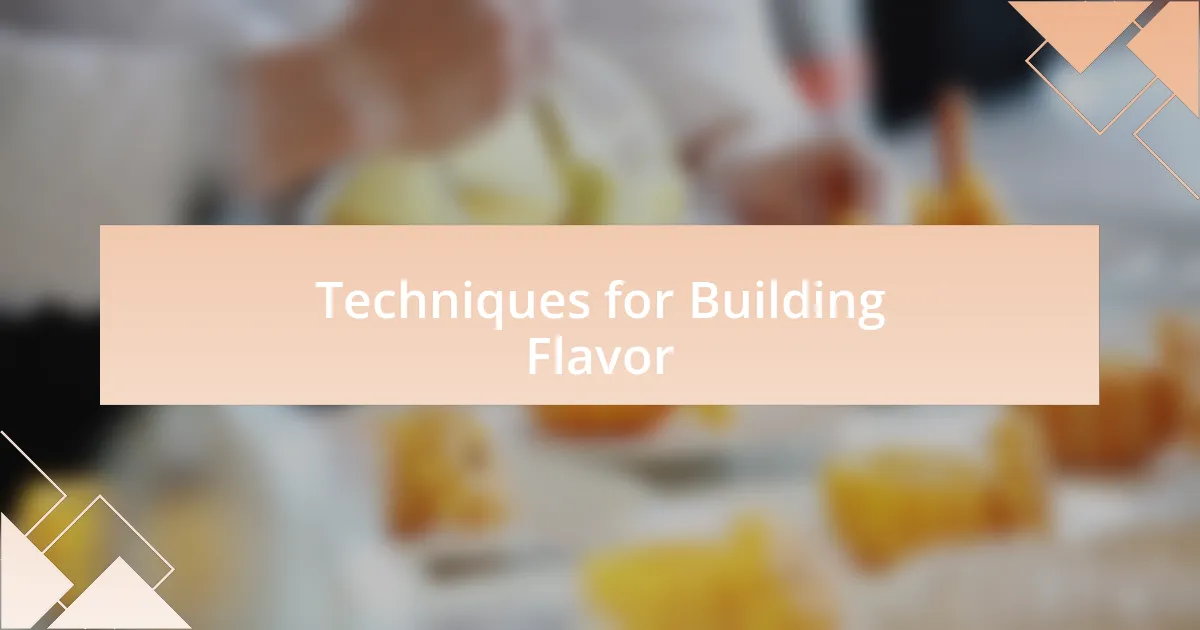
Techniques for Building Flavor
Building flavor in pasta isn’t just about the ingredients; it’s about how you treat them during the cooking process. One technique I embraced is to toast my spices before adding them to the sauce. I vividly remember the first time I toasted red pepper flakes in olive oil—it was as if a whole new dimension of flavor emerged, sending my taste buds into a delightful frenzy. Have you ever tried this simple step? It transforms the usual into something extraordinary.
Another crucial technique is to create depth through layering flavors. When I simmer sauces, I always start with a base of onions and garlic. I remember the first time I let them sauté longer than usual, until they caramelized. The sweetness and richness that developed were spectacular, creating a foundation that brought my dish to life. Just think about it: how often do we rush that initial step?
Finally, I like to finish my pasta dishes with an acid—a squeeze of fresh lemon or a dash of balsamic vinegar can brighten and enhance the overall flavor profile. One evening, I topped a rich ragù with freshly squeezed lemon juice, and the result was nothing short of a revelation. It cut through the heaviness and made each bite refreshing. Have you experienced the magic that a splash of acidity can bring? It’s truly a game changer in the kitchen.

My Personal Pasta Journey
My fascination with pasta started when I was a child, eagerly watching my grandmother roll out thin sheets of dough. The rhythmic sound of the rolling pin against the counter is a memory that brings me warmth and joy. Do you have a moment from your childhood that ignited your love for cooking? For me, that moment sparked a lifelong passion for crafting delicious dishes.
As I grew older, I began experimenting with different pasta recipes, leading to a delightful journey of discovery. I recall the first time I added roasted butternut squash to a creamy sauce; the result was a harmonious blend of sweetness and indulgence that danced on my palate. It’s funny how a simple ingredient can transform a familiar dish into something unexpected, isn’t it? That experience taught me to embrace creativity in the kitchen.
In my quest for the perfect homemade pasta, I once faced a disaster that turned into a valuable lesson. During a dinner party, my dough refused to cooperate, resulting in an uneven texture. Instead of panicking, I decided to turn it into a learning opportunity. I showcased the process and chatted with my guests about how imperfections can lead to unique creations. Have you ever turned a kitchen mishap into a charming story? That night, we shared laughter, and I realized that pasta is not just about perfection—it’s about the joy of the experience.
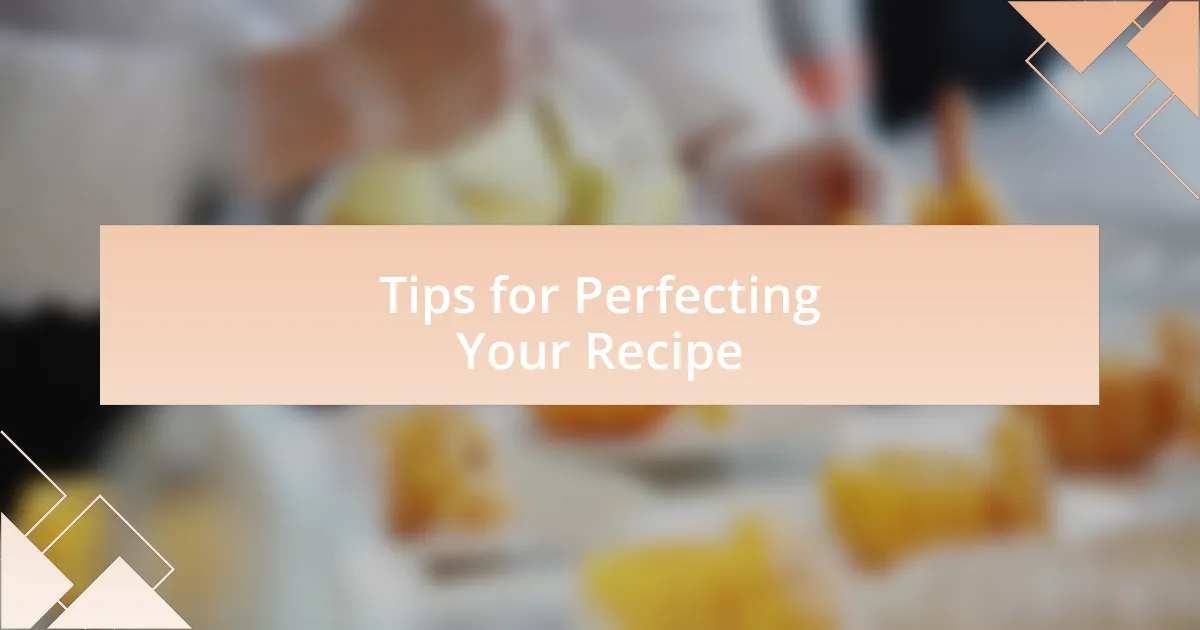
Tips for Perfecting Your Recipe
When perfecting your pasta recipe, one key tip is to trust your senses. I remember the first time I tried tasting the sauce as it simmered. The aroma as it blossomed was intoxicating, guiding me to adjust the seasoning just right. Have you paused to really savor your cooking? Often, your taste buds are your best tool for achieving balance and flavor.
Another important aspect is the quality of your ingredients. I learned this lesson the hard way during a pasta night with friends when I used pre-packaged cheese instead of fresh. The subtle, creamy flavor of high-quality cheese can elevate your dish tremendously. Have you ever thought about how much a simple ingredient swap can transform your meal?
Don’t shy away from experimenting. One night, feeling adventurous, I decided to throw in some lemon zest along with traditional garlic and herbs into my sauce. It provided a fresh pop that startled but delighted my guests, and it reminded me that cooking is as much about exploration as it is about following a recipe. Have you let spontaneity guide you in the kitchen? Embracing the unexpected can lead to your most memorable culinary moments.

Sharing My Customized Creation
Sharing my customized pasta creation is like inviting others into my culinary journey. Recently, I hosted a small gathering and decided to serve my signature dish. As I plated the pasta, I felt an exhilarating mix of excitement and nostalgia, remembering countless evenings spent experimenting in my kitchen. Have you ever felt that thrill when sharing something you’ve poured your heart into?
It’s not just about the flavors but also the stories that come with them. The last time I made my customized recipe, I included a family secret—a touch of vodka in the sauce. As I served it, I shared the memory of the Italian grandmother who taught me that little trick. I could see my friends’ eyes light up, eager to savor both the flavors and the history behind them. Isn’t it remarkable how food can bridge generations and spark conversations?
I also believe that sharing a customized dish is an act of love. When my friend took a bite and exclaimed how the unique blend of herbs made the dish so much more vibrant, I felt a wave of joy. It’s validating to see others appreciate the nuances that I’ve carefully curated. Have you ever noticed how a shared meal can foster deep connections? In those moments, I’m reminded that my passion for pasta isn’t just about satisfying hunger; it’s about creating memories together.